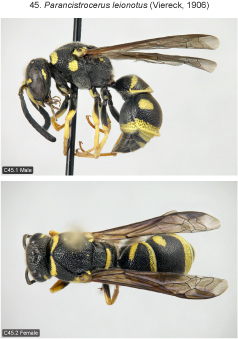
| Home | Table of contents | Keys | Species list | Glossary | Image data | PDF | Cite this article | Feedback | Updates |
Identification Atlas of the Vespidae (Hymenoptera, Aculeata) of the northeastern Nearctic region
CJAI 05, February 19, 2008
doi: 10.3752/cjai.2008.05
Matthias Buck, Stephen A. Marshall, and David K.B. Cheung
Department of Environmental Biology, University of Guelph, Guelph, Ontario, Canada N1G 2W1
Next species | Previous species | Key
45. Parancistrocerus leionotus (Viereck, 1906)
Figs B2.12; B7.6, 28, 50; C45.1–5.

|

|
Species recognition. This relatively large species is similar to P. vagus, but these species rarely occur together (distinction see under that species). The male of the similar P. pedestris lacks distinct ocellar tubercles and discal spots of tergum 1; both sexes have a medially interrupted pronotal carina (entire in P. leionotus) and tergum 3 usually lacks the apical fascia (if present, it is almost always interrupted).
Variation. Fore wing length 5.5–7.5 mm (♂♂), 6.0–8.0 mm (♀♀). Ocellar tubercles more strongly developed in male than in female, in the latter often not projecting above level of hind ocellus in lateral view. Long hairs near summit of tergum 1 sometimes quite sparse. Thickening of apical margin of tergum 2 variable, its thickness 0.4–1.1x mid ocellar diameter (male) or 0.2–0.7x mid ocellar diameter (female). Body with pale markings usually bright yellow but one male from Walpole I. with somewhat pale yellow markings. The only known female from Manitoba is marked with ivory and has a scarcely thickened apical margin of tergum 2, as described for the ssp. yumus (see below). Female clypeus with a pair of yellow dorsal spots, sometimes coalescent to form a crescent-shaped mark, rarely completely black or with an additional, smaller pair of ventral spots. Interantennal spot usually extending almost to clypeus in male, in female and some males restricted to area above interantennal tubercle. In male yellow spot along inner eye margin often extending to clypeus ventrally, sometimes interrupted at level of antenna. Postocular spot rarely absent in male. Transverse pronotal band sometimes more or less emarginate on each side. Scutum with a small to minute posteromedian spot in ca. one third of females. Propodeum in female with a pair of elongate spots from dorsum along lateral ridge to just above submarginal carina, sometimes interrupted near middle or rarely reduced to a dorsal or ventral spot, exceptionally almost completely black; male propodeum entirely black or with a pair of dorsal spots, very rarely with small ventrolateral spots as well. Terga 1–(4)5 (female) or 1–(5)6 (male) with apical fasciae, the one on tergum 3 not interrupted medially (except in one female). Discal spots of terga 1 and 2 always present in both sexes, the former often connected to apical fascia. Female sternum 2 with apical fascia (rarely interrupted near middle), sides of sternum 3 with apical spots; male sterna 2–3(4) with apical fascia, the one on sternum 3 sometimes interrupted or laterally abbreviated, evanescent fascia sometimes also present on sternum 1, discal spots sometimes present on sternum 2.
Distribution. Canada: ON, newly recorded for MB (?ssp. yumus). U.S.: widely distributed excluding Pacific Coast states (Krombein 1979). The ssp. yumus (Viereck, 1908) has whitish markings and an only slightly thickened apical margin of tergum 2; it ranges from CO south to AZ and western TX (Krombein 1979).
Biology. The biology of P. leionotus was previously unknown. The species differs markedly from related species by using small cavities in rocks or concrete as nest sites. At Oakville, 16 Mile Creek the species was very common around a steep storm drainage gully that was laid out with mid-size limestone boulders. Both males and females were frequently seen flying over the rock surface, occasionally landing on the rocks. Apparently, the limestone provided abundant nesting opportunities because of the prevalence of small cavities in this type of rock. On 25 June, 2005, a female was seen entering a small cavity on the lower surface of a rock. The opening of the cavity had already been narrowed with mud. The female did not carry any prey but three other females were collected while carrying small caterpillars. A similar, already closed nest was discovered at the same locality and brought back to the lab, but nothing emerged. Unlike its relatives P. vagus, P. pedestris and P. pensylvanicus, which inhabit open woodlands, P. leionotus occurs in more sparsely vegetated, usually disturbed areas such as wastelands, roadsides, or industrial properties.
Next species | Previous species | Key
| Home | Table of contents | Keys | Species list | Glossary | Image data | PDF | Cite this article | Feedback | Updates |
